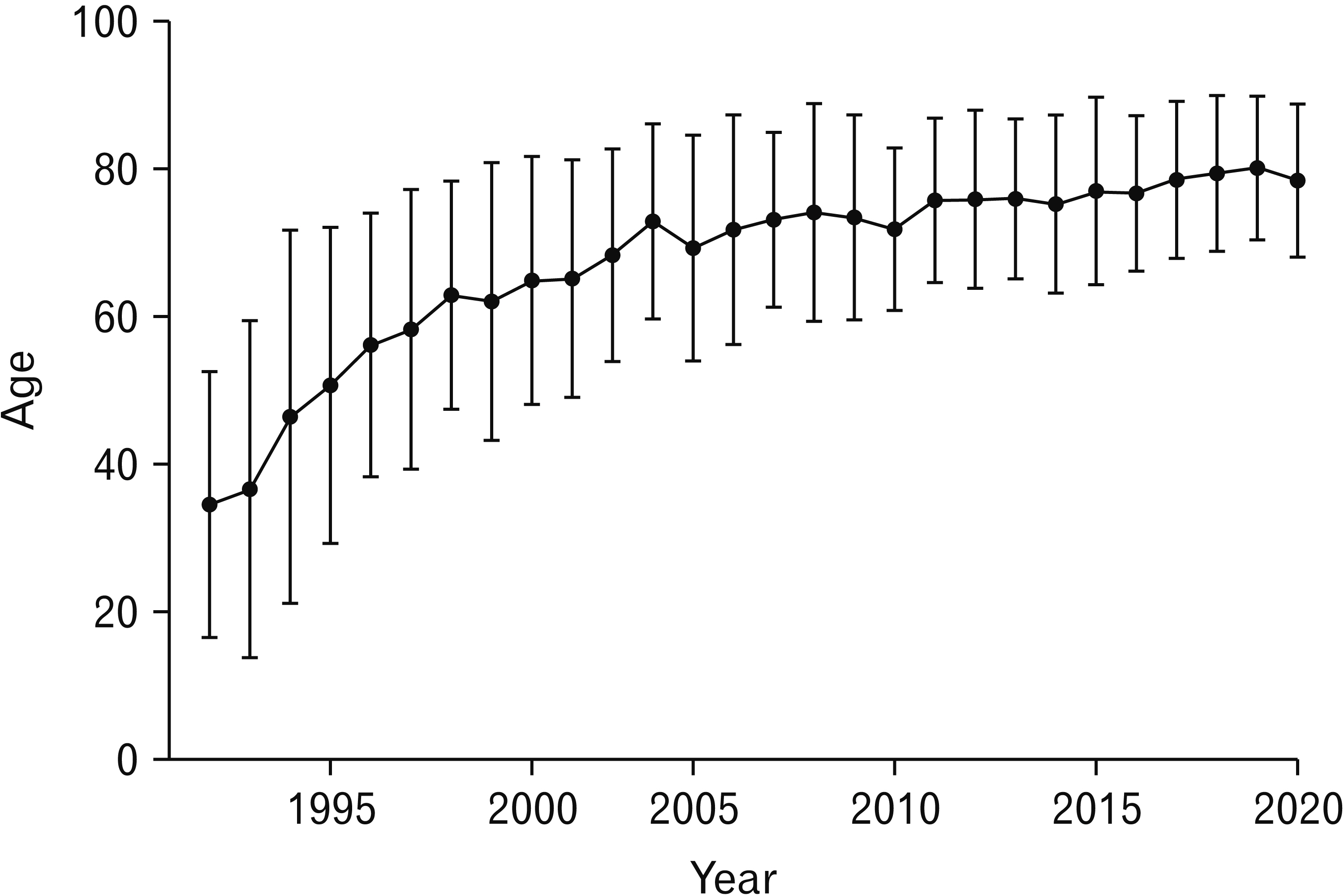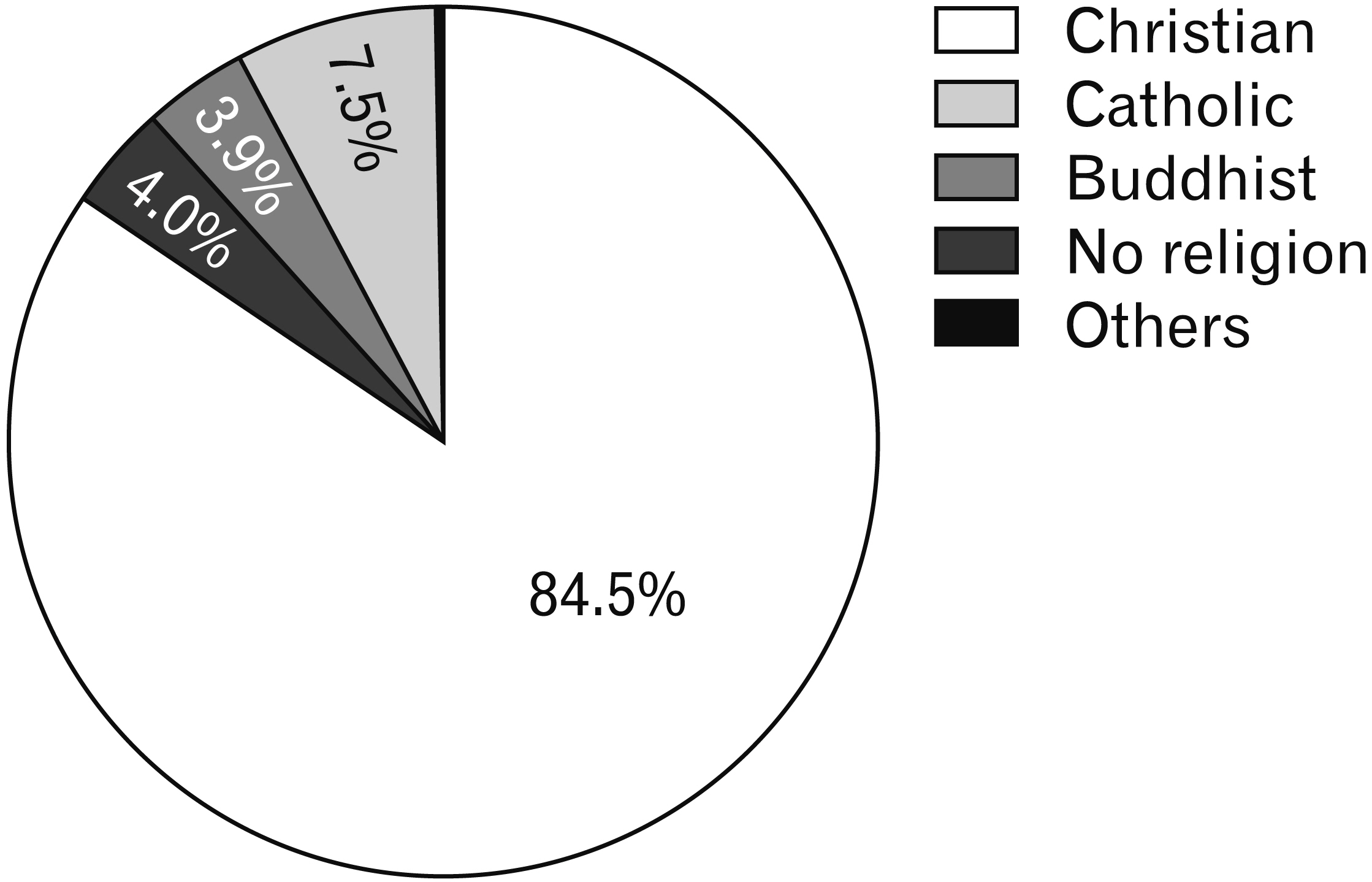Body donation trends in Yonsei University: a statistical analysis of donor records
- Affiliations
-
- 1Division in Anatomy and Developmental Biology, Department of Oral Biology, Human Identification Research Institute, BK21 FOUR Project, Yonsei University College of Dentistry, Seoul, Korea
- 2BSc Psychology, Department of Health and Science, Coventry University, Coventry, United Kingdom
- 3Department of Psychology, New York University, New York, NY, 4 MD Candidate, Eastern Virginia Medical School, Norfolk, VA, USA
- 4Department of Advanced General Dentistry, Human Identification Research Institute, Yonsei University College of Dentistry, Seoul, Korea
- 5Department of Orthopaedic Surgery, Arthroscopy and Joint Research Institute, Yonsei University College of Medicine, Seoul, Korea
- KMID: 2514584
- DOI: http://doi.org/10.5115/acb.20.261
Abstract
- Body donation trends in Korea have changed significantly over the last 3 decades. Establishing a body donation system will promote donations to universities for academic purposes. Yonsei University College of Medicine started its own body donation system in 1992, including documenting donors’ records. However, there has been no reported attempt to analyze the trend of these records, which could provide noteworthy information that can be interpreted for medical advances. This study performed a statistical analysis of the donors’ records between 1992 and 2019 to analyze the sociological and anthropological changes. Donor personal information such as sex, age, religion, and place and cause of death were extracted from the Yonsei University College of Medicine database. Our statistical analysis revealed significant correlations between donors’ records and the changes in the number of geriatric hospitals, religious beliefs, number of donations, and donor age.
Keyword
Figure
Cited by 2 articles
-
The creation of a body donation program at Federal University of Juiz de Fora in Brazil: academic importance, challenges and donor profile
André Gustavo Fernandes de Oliveira, Augusto Ferreira Gonçalves, Júlia Nunes Soares, Letícia Henriques Neto Salgado, Bruno Silveira Santana, Matheus Venâncio Passos, Juliana Lopes de Oliveira Reis, Gustavo Candiá Arantes, Luís Filipe Sarmento Campos, Matheus Souza Carvalho, Lucas Cotrim Furtado da Gama, Alice Belleigoli Rezende
Anat Cell Biol. 2021;54(4):489-500. doi: 10.5115/acb.21.096.Anatomy acts concerning body and organ donations across the globe: past, present and future with a special emphasis on the indian scenario
Surraj Susai, Mrudula Chandrupatla, Rohini Motwani
Anat Cell Biol. 2023;56(1):1-8. doi: 10.5115/acb.22.166.
Reference
-
References
1. Korean Association of Anatomists. 2017. History of Korea anatomy. Korean Association of Anatomists;Seoul:2. Saha A, Sarkar A, Mandal S. 2015; Body donation after death: the mental setup of educated people. J Clin Diagn Res. 9:AC05–9. DOI: 10.7860/JCDR/2015/12246.6011. PMID: 26266106. PMCID: PMC4525495.
Article3. Park JT, Jang Y, Park MS, Pae C, Park J, Hu KS, Park JS, Han SH, Koh KS, Kim HJ. 2011; The trend of body donation for education based on Korean social and religious culture. Anat Sci Educ. 4:33–8. DOI: 10.1002/ase.198. PMID: 21265035.
Article4. Ralph AF, Alyami A, Allen RD, Howard K, Craig JC, Chadban SJ, Irving M, Tong A. 2016; Attitudes and beliefs about deceased organ donation in the Arabic-speaking community in Australia: a focus group study. BMJ Open. 6:e010138. DOI: 10.1136/bmjopen-2015-010138. PMID: 26787253. PMCID: PMC4735320.
Article5. Statistics Korea. c2020. Preliminary results of birth and death statistics in 2019 [Internet]. Statistics Korea;Daejeon: Available from: https://stats.oecd.org/Index.aspx?QueryId=30142. cited 2020 Jul 20.6. The Academy of Korean Studies. 2017. Encyclopedia of Korean Culture [Internet]. The Academy of Korean Studies;Seongnam: Available from: https://encykorea.aks.ac.kr/Contents/Item/E0041280. cited 2017 Jun 22.7. Aveline-Dubach N. 2012. Invisible population: the place of the dead in East Asian megacities. Lexington Books;Lanham:8. Bautista J, Lim FKG. 2009. Christianity and the state in Asia: complicity and conflict. Routledge;London: DOI: 10.4324/9780203883761.9. Korea Evangelical Fellowship. 1998. Korea church and funeral culture [Internet]. Korea Evangelical Fellowship;Seoul: Available from: https://www.cjob.co.kr/christianity/1351. cited 2020 Nov 15.10. Ministry of Health and Welfare (MOHW). 2019. The cremation rate in 2017 [Internet]. Ministry of Health and Welfare;Sejong: Available from: http://www.mohw.go.kr/react/index.jsp. cited 2020 Aug 1.11. Health Insurance Review and Assessment Service (HIRA). c2020. Health insurance nursing facility statistical status (2007-2011) [Internet]. Health Insurance Review and Assessment Service;Wonju: Available from: https://www.hira.or.kr/bbsDummy.do?pgmid=HIRAA020045010000. cited 2020 Jul 30.12. Park CW. 2010. Cultural blending in Korean death rites: new interpretive approaches. Continuum;London:13. Yeo IS, Shin KH. 2015. The debate over Jejungwon succession. Yeogsagonggan;Seoul:14. Cho KH, Chung Y, Roh YK, Cho B, Kim CH, Lee HS. 2004; Health care for older persons: a country profile-Korea. J Am Geriatr Soc. 52:1199–204. DOI: 10.1111/j.1532-5415.2004.52322.x. PMID: 15209662.
Article15. Organisation for Economic Co-operation and Development (OECD). 2020. Health statistics. Long term care hospital beds in OECD countries 2014 [Internet]. Organisation for Economic Co-operation and Development;Paris: Available from: https://www.oecd.org/els/health-systems/. cited 2020 Jul 20.16. Song HJ. 2011; Current status and policy issues of geriatric hospitals. Health Insur Rev Assess Serv. 5:5–13.17. Healthcare Bigdata Hub. c2020. Number of nursing facilities in Korea [Internet]. Health Insurance Review and Assessment Service;Wonju: Available from: https://opendata.hira.or.kr/home.do. cited 2020 Aug 6.
- Full Text Links
- Actions
-
Cited
- CITED
-
- Close
- Share
- Similar articles
-
- A Phenomenological Study for Bereaved Families Who Experienced Body Donation
- A Study about the Directed blood donation program
- Factors Influencing Family's Organ Donation Decision
- A Study on the Relationship between the Awareness of Blood Program and the Blood Donation Experience
- Effects of the register to become an organ donor on the organ donation agreement rate



